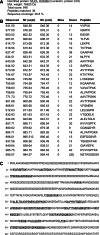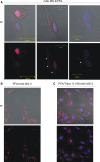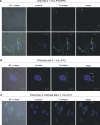The new face of nucleolin in human melanoma
- PMID: 19363676
- PMCID: PMC11030984
- DOI: 10.1007/s00262-009-0705-8
The new face of nucleolin in human melanoma
Abstract
Nucleolin is multifunctional protein mainly present in nucleoli but also detected in cytoplasm and plasma membranes. Extranuclear nucleolin differs from the nuclear form by its glycosylation. Studies on expression of nucleolin in breast cancer suggest a possible association to the metastatic cascade. In the present study, Vicia villosa lectin (VVL) precipitation followed by subsequent polyacrylamide gel electrophoresis and mass spectrometry analysis demonstrates nucleolin as a VVL-positive glycoprotein expressed in melanoma. The presence of VVL-positive nucleolin in the melanoma cell membrane and cytoplasm was confirmed by confocal microscopy. Using bioinformatic peptide prediction programs, nucleolin was shown to contain multiple possible MHC class-I binding peptides in its sequence which makes nucleolin an interesting melanoma marker and target for immunodiagnostic and possibly therapeutic purposes.
Figures






Similar articles
-
The lectin-binding pattern of nucleolin and its interaction with endogenous galectin-3.Cell Mol Biol Lett. 2014 Sep;19(3):461-82. doi: 10.2478/s11658-014-0206-4. Epub 2014 Aug 29. Cell Mol Biol Lett. 2014. PMID: 25169435 Free PMC article.
-
Targeting surface nucleolin with a multivalent pseudopeptide delays development of spontaneous melanoma in RET transgenic mice.BMC Cancer. 2010 Jun 24;10:325. doi: 10.1186/1471-2407-10-325. BMC Cancer. 2010. PMID: 20573279 Free PMC article.
-
Nucleolin undergoes partial N- and O-glycosylations in the extranuclear cell compartment.Biochemistry. 2005 Apr 19;44(15):5804-15. doi: 10.1021/bi047831s. Biochemistry. 2005. PMID: 15823039
-
The roles of nucleolin subcellular localization in cancer.Biochimie. 2015 Jun;113:78-85. doi: 10.1016/j.biochi.2015.03.023. Epub 2015 Apr 9. Biochimie. 2015. PMID: 25866190 Review.
-
Plant nucleolar DNA: Green light shed on the role of Nucleolin in genome organization.Nucleus. 2017 Jan 2;8(1):11-16. doi: 10.1080/19491034.2016.1236167. Epub 2016 Sep 20. Nucleus. 2017. PMID: 27644794 Free PMC article. Review.
Cited by
-
Interplay between αvβ3 integrin and nucleolin regulates human endothelial and glioma cell migration.J Biol Chem. 2013 Jan 4;288(1):343-54. doi: 10.1074/jbc.M112.387076. Epub 2012 Nov 16. J Biol Chem. 2013. PMID: 23161541 Free PMC article.
-
A novel nucleolin-binding peptide for Cancer Theranostics.Theranostics. 2020 Jul 14;10(20):9153-9171. doi: 10.7150/thno.43502. eCollection 2020. Theranostics. 2020. PMID: 32802184 Free PMC article.
-
Nucleolin as cell surface receptor for tumor necrosis factor-alpha inducing protein: a carcinogenic factor of Helicobacter pylori.J Cancer Res Clin Oncol. 2010 Jun;136(6):911-21. doi: 10.1007/s00432-009-0733-y. Epub 2010 Jan 5. J Cancer Res Clin Oncol. 2010. PMID: 20049476 Free PMC article.
-
Pleiotrophin expression and role in physiological angiogenesis in vivo: potential involvement of nucleolin.Vasc Cell. 2012 Mar 16;4:4. doi: 10.1186/2045-824X-4-4. Vasc Cell. 2012. PMID: 22423616 Free PMC article.
-
Effect of nucleolin on adriamycin resistance via the regulation of B-cell lymphoma 2 expression in Burkitt's lymphoma cells.J Cell Physiol. 2019 Dec;234(12):22666-22674. doi: 10.1002/jcp.28833. Epub 2019 May 24. J Cell Physiol. 2019. PMID: 31127617 Free PMC article.
References
-
- Bubenik J. MHC class I down-regulation, tumour escape from immune surveillance and design of therapeutic strategies. Folia Biol (Praha) 2005;51:1–2. - PubMed
-
- Chen C, Chiang S, Yeh N. Increased stability of nucleolin in proliferating cells by inhibition of its self-cleaving activity. J Biol Chem. 1991;266:7754–7758. - PubMed
Publication types
MeSH terms
Substances
LinkOut - more resources
Full Text Sources
Medical
Research Materials

